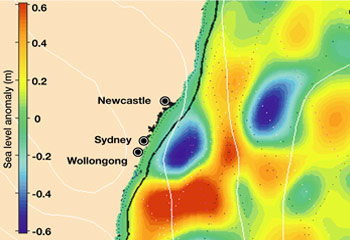

Monster whirlpool off SydneyMarch 14, 2007 12:00
|
 |
A MASSIVE, mysterious whirlpool of cold water has developed off the coast of Sydney, forcing the sea surface to fall almost 1m and ocean currents to change course.
Dubbed a sea "monster" by CSIRO oceanographers, the huge body of water stretches almost 200km across and plunges 1000m towards the ocean floor. Its centre sits just 100km off the coast of Sydney and could stay there for months.
Scientists are baffled by the powerful cold-water eddy, which is invisible to the human eye but can be tracked through satellite images.
At its centre the sea level has dropped by 70cm, while the water 400m below the surface is 6C colder than normal at that depth.
The East Australian Current has been forced to divert around the eddy, which takes one week to do a full rotation in a clockwise direction. A second eddy of similar proportions is sitting further out from the coast.
CSIRO satellite oceanographer Dr David Griffin said fishers passing through the eddies in their boats would not feel the slow whirlpools.
However, they would notice a line of debris forming at the edges.
Beachgoers can feel the effects of the whirlpool closer to shore as it forces water from the ocean depths up over the continental shelf.
The cooler water can bring down the temperature at Sydney's beaches by several degrees.
Oceanographers noticed the eddy forming in January.
Dr Griffin said it contributed to the surprisingly cool sea temperatures – down to a numbing 14C – swimmers felt at their favourite spots this summer.
"To break a (temperature) record like that you need a bunch of things to happen," Dr Griffin said.
But fish and other marine life felt the changes most, he said. Some would be attracted to the cooler water and others would shy away.
Experts are unsure how long the two whirlpools will sit off Australia's east coast, or how they will affect marine ecosystems.
"The eddies in this part of the world are very hard to predict," Dr Griffin said.
They naturally drift westwards but keep bumping up against the shore and may be re-energised by other tidal and weather patterns, he said.
The whirlpool will today be discussed in Hobart at a meeting of 200 Australian, European and US scientists working with satellite images to map water temperatures.
Explaining the image
Variations in sea levels above or below the normal are shown, with the two icy whirlpools in dark blue because the deep cold water has helped pull the ocean surface down by around 70cm.
The icy whirlpool closest to Sydney is 200kms across and plunging 1km towards the ocean floor. It's about 100km east of Sydney and moving clockwise.
The warmer East Australian Current, shown in red and yellow, has been squeezed between the two icy whirlpools and also detours around them.
The cold whirlpools could last anywhere from two weeks to several months.
Source:
http://www.news.com.au/dailytelegraph/story/0,22049,21376947-5006009,00.html?from=public_rss